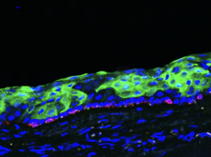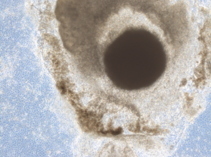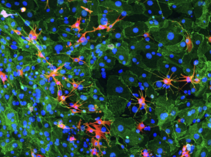Polisetti Lab
Ocular surface reconstruction and transplantation biology
The ocular surface, comprising the cornea, conjunctiva, and limbus, plays a vital role in maintaining corneal transparency and visual function. Its homeostasis relies on a delicate balance between epithelial renewal and repair, supported by unipotent stem/progenitor cells located at the corneoscleral limbus.
Disorders of the ocular surface – such as chemical or thermal burns, infections, and autoimmune diseases - can disrupt this balance, leading to impaired healing and loss of transparency. One of the most severe consequences is limbal stem cell deficiency (LSCD), where damage to the stem cell reservoir or its microenvironment results in corneal neovascularization and progressive visual deterioration.
Transplantation of ex vivo expanded limbal epithelial stem/progenitor cells (LEPC) is an established strategy for treating LSCD. In unilateral LSCD, long-term success depends on maintaining LESCs within the graft, which relies on the niche microenvironment regulating stem cell homeostasis. In bilateral cases, success remains limited due to donor scarcity and the need for prolonged systemic immunosuppression.
Our research focuses on understanding ocular surface pathology at the cellular and molecular levels, identifying novel therapeutic targets, and developing alternative autologous stem cell sources for ocular surface restoration. We are also designing biomimetic scaffolds that replicate the biological niche in vitro to enhance graft success

Projects
Physiology and Pathology of the ocular surface
We study the cellular and molecular interactions within the limbal stem cell niche, focusing on the role of epithelial cells and melanocytes in maintaining corneal homeostasis and improving graft outcomes. A detailed understanding of the tissue microenvironment at the cellular and molecular level is crucial for identifying novel therapeutic targets for ocular surface diseases such as LSCD, pterygium, and conjunctival/limbal melanoma. Characterizing these tissues at the cellular and molecular levels will help uncover disease-specific markers and pathways, guiding the development of targeted therapies to improve clinical outcomes.
Stem cell therapy – Induced pluripotent stem cells (iPSCs)
Our research aims to develop stem cell-based therapies for ocular surface disorders, particularly LSCD. iPSCs are a promising alternative to allogenic limbal grafts for generating corneal epithelial cells. We aim to efficiently produce and purify these cells, testing their biocompatibility in animal models for future clinical use. In parallel, we are creating biomaterials such as decellularized corneal tissue to design scaffolds for limbal stem cell transplantation, with the aim of translating these approaches into clinical practice.
Publications
ORCID ID Naresh Polisetti https://orcid.org/0000-0001-8669-0388

Dr. Naresh Polisetti
naresh.polisetti@uniklinik-freiburg.de
Team Members
- René Pöttke, Lab Technician
- Dr. Benjamin Roschinski, MD
- Michael Bucher, MD
- Eva Ulrich, MD student
- Sebastian Kistenmacher, MD student
- Moritz Braunsperger, MD student
- Tabea Herzig, MD student
- Isabell Kußberger, MD student
Scientific advisors
- Prof. Dr. Thomas Reinhard, MD
- Prof. Dr. Günther Schlunck, MD
Collaborators
Prof. Dr. U. Schlötzer-Schrehardt, Department of Ophthalmology, Universitätsklinikum Erlangen
Prof. Dr. R. Schäfer, Institute for Transfusion Medicine and Gene Therapy, Universitätsklinikum Freiburg
- Dr. M. Notara, Corneal Stem Cell Biology, Translational Experimental Ophthalmology Cologne
Funding
Deutsche Forschungsgemeinschaft (DFG)
Forschungskommission der Medizinischen Fakultät, Universitätsklinikum Freiburg




